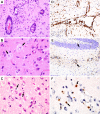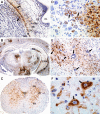La Crosse virus infectivity, pathogenesis, and immunogenicity in mice and monkeys
- PMID: 18267012
- PMCID: PMC2276200
- DOI: 10.1186/1743-422X-5-25
La Crosse virus infectivity, pathogenesis, and immunogenicity in mice and monkeys
Abstract
Background: La Crosse virus (LACV), family Bunyaviridae, was first identified as a human pathogen in 1960 after its isolation from a 4 year-old girl with fatal encephalitis in La Crosse, Wisconsin. LACV is a major cause of pediatric encephalitis in North America and infects up to 300,000 persons each year of which 70-130 result in severe disease of the central nervous system (CNS). As an initial step in the establishment of useful animal models to support vaccine development, we examined LACV infectivity, pathogenesis, and immunogenicity in both weanling mice and rhesus monkeys.
Results: Following intraperitoneal inoculation of mice, LACV replicated in various organs before reaching the CNS where it replicates to high titer causing death from neurological disease. The peripheral site where LACV replicates to highest titer is the nasal turbinates, and, presumably, LACV can enter the CNS via the olfactory neurons from nasal olfactory epithelium. The mouse infectious dose50 and lethal dose50 was similar for LACV administered either intranasally or intraperitoneally. LACV was highly infectious for rhesus monkeys and infected 100% of the animals at 10 PFU. However, the infection was asymptomatic, and the monkeys developed a strong neutralizing antibody response.
Conclusion: In mice, LACV likely gains access to the CNS via the blood stream or via olfactory neurons. The ability to efficiently infect mice intranasally raises the possibility that LACV might use this route to infect its natural hosts. Rhesus monkeys are susceptible to LACV infection and develop strong neutralizing antibody responses after inoculation with as little as 10 PFU. Mice and rhesus monkeys are useful animal models for LACV vaccine immunologic testing although the rhesus monkey model is not optimal.
Figures





References
Publication types
MeSH terms
Substances
LinkOut - more resources
Full Text Sources
Other Literature Sources
Research Materials

